The journey for a stronger, well-defined chest is a common thread that unites many gym-goers. It’s not just about looks – a strong chest is crucial for overall upper body strength, and for numerous physical activities. For building mass in your chest, dumbbells are an amazing option.
One study has shown that dumbbell exercises in enhance muscle activation and range of motion, emphasizing the importance of using dumbbells for varied angles and muscle isolation (Christian et al., 2023).
Whether you are trying to add more dumbbell chest exercises to your push day workout, or try something other than the traditional bench press, we got you covered. This article will be your ultimate guide to maximizing your chest gains with a simple yet versatile piece of workout equipment: the dumbbell.
Remember that mastering any form of exercise takes time, so be patient with yourself as you journey through dumbbell chest workouts – it’s about progress not perfection!
The 11 Best Dumbbell Chest Exercises
1. Dumbbell Bench Press

The dumbbell bench press is an essential exercise to the workout routine of anyone looking to build and shape their chest. This is a classic weightlifting workout, and it stands as a fundamental starting point for all.
This compound movement primarily targets the pectoralis major but also engages the anterior deltoids, triceps brachii, and serratus anterior muscles.
As early as 1 week into high-intensity bench press training, the pectoralis major gained significant muscle mass, and 3 weeks of training bench press led to a significant increase in 1-RM (one repetition maximum) strength (Ferreira et al. (2017)).
How to do it:
- Lie flat on a bench with your feet firmly planted on the ground.
- Hold a dumbbell in each hand, held at chest level.
- With a dumbbell in each hand at chest level, extend your arms directly above until they are straight but not locked at your elbows.
- Lower the dumbbells back down in a controlled manner until they reach chest level.
- Repeat for the desired number of repetitions.
To optimize muscle engagement, squeeze your chest muscles when you reach the top of each repetition before slowly lowering the weights back to starting position.
2. Dumbbell Chest Fly
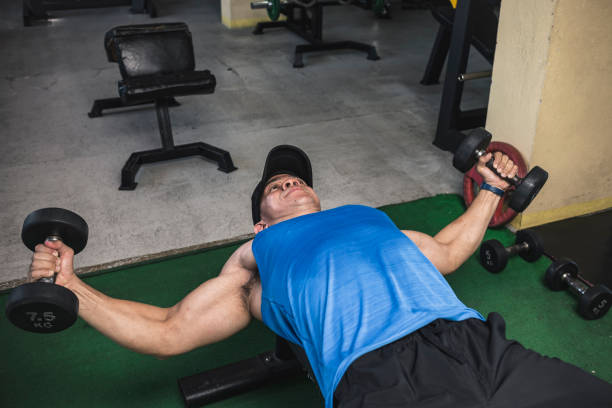
The beauty of Dumbbell Chest Fly lies in its ability to isolate pectoral muscles unlike compound exercises such as presses which involve additional muscle groups like the triceps or shoulders. Isolation results not only in enhanced muscular endurance but also better definition and symmetry across the entire chest, making it an absolute favorite amongst bodybuilders.
One study has shown that the dumbbell fly showed significantly higher muscle activation in the biceps brachii than the bench press. This means the fly is great for engaging the arms, which may be beneficial for extra bicep growth.
The dumbbell fly was also shown beneficial for groups needing strength, stabilization, and control in movements involving horizontal shoulder flexion. This could include rehabilitation scenarios or sports-specific training (Solstad et al. (2020)).
How to do it:
- To start with, position yourself flat on a bench or mat with a dumbbell in each hand.
- Extend your arms above your chest with a slight bend at the elbows, resembling an arched position like wings; hence, it’s often referred to as “flying.”
- Slowly lower both arms out wide to your sides while maintaining the bend in your elbows until you feel a stretch across your chest.
- Bring back both weights together above your chest by squeezing your pecs
- Repeat this movement pattern for several reps and sets depending upon individual capacity and training level.
One suggestion for those struggling with shoulder discomfort while performing this exercise is to limit their range of motion by not lowering their hands beyond shoulder level during the eccentric phase, which can put undue pressure on rotator cuffs.
3. Dumbbell Pullover
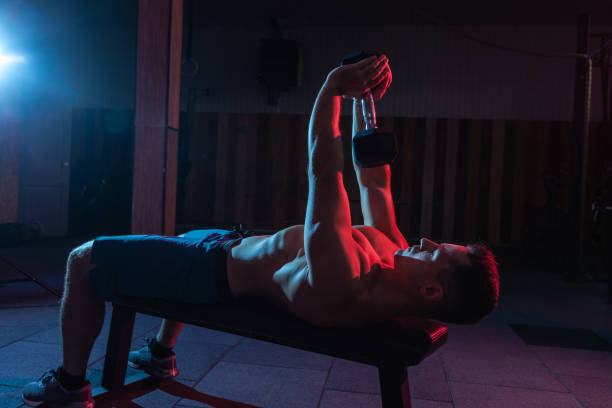
The dumbbell pullover, often an underrated gem for the chest, is a powerful exercise. This exercise goes beyond just targeting your pecs; it brings into play a diverse range of muscle groups including your latissimus dorsi, triceps, and serratus anterior.
How to do it:
- To initiate a dumbbell pullover, lie down perpendicularly on a flat bench with only your shoulders resting on the surface.
- Your feet should be firmly planted on the ground and your hips slightly dropped lower than the bench for stability.
- Hold a dumbbell using both hands above your chest with arms fully extended but not locked at elbows.
- Lower the weight in an arc-like motion behind your head until you feel a stretch in your chest is key.
- Once you’ve reached this point, use your pec muscles to pull up and return to starting position while keeping control of movement steady at all times.
The dumbbell pullover’s overall effectiveness lies in its ability to induce an intense stretch throughout numerous muscle fibers simultaneously.
4. Incline Dumbbell Chest Press
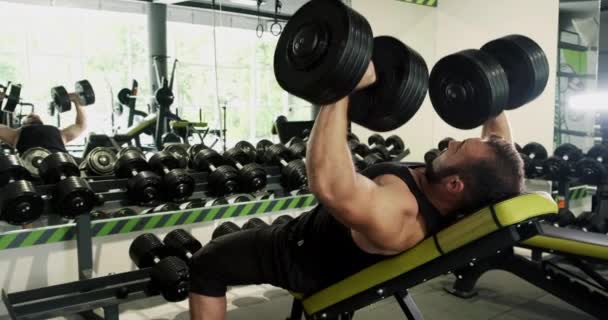
Incline Dumbbell Chest Presses target the clavicular head of the pectoralis major, an area often overlooked in chest workouts. This targeting of the upper pectoral muscles is crucial for achieving balanced muscle development (Muyor et al., 2021).
How to do it:
- Begin by adjusting your workout bench to an incline position, preferably between 30 to 45 degrees. This inclined angle is crucial as it allows the stress of the weight to shift towards the upper chest muscles.
- Start by sitting on the bench with a dumbbell in each hand placed on your thighs.
- Lean back allowing both weights to rest on your abdomen momentarily.
- Now, use your thighs to help “kick” each weight one at a time into starting position at shoulder width apart.
- As you press up with both arms fully extended, concentrate on utilizing every fiber of your upper chest muscles rather than relying solely on arm strength. The critical point here is not just how high you can push but how well you can contract and squeeze those upper pecs throughout each rep.
- As you lower the weights down slowly and under control, let your elbows flare out naturally while maintaining a slight bend in them; they should never be locked nor overly flexed during this movement.
5. Dumbbell Squeeze Press
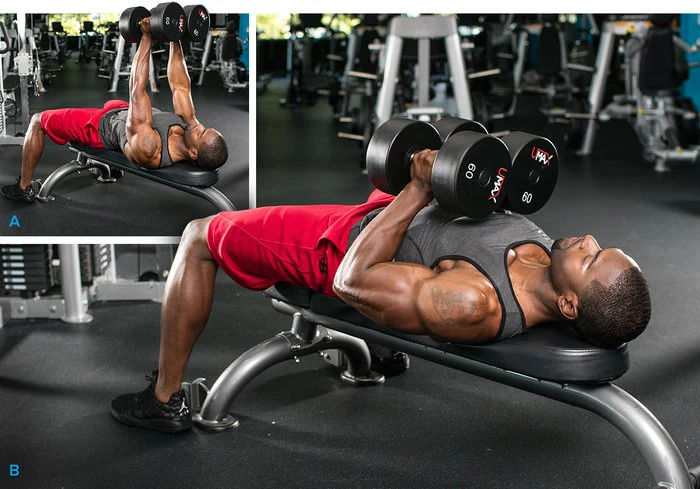
The Crush Grip Dumbbell Press, though lesser-known, is a great addition to your chest routine. It works by engaging not just your pectorals but also your triceps and deltoids. This is a great chest workout for people experiencing shoulder injuries, as it adds more pressure on the triceps, while isolating the chest.
How to do it:
- Start by lying on a bench with a dumbbell in each hand.
- Bring the dumbbells together so that they are touching each other, palms facing towards you — this is what’s known as the crush grip.
- Ensure that you’re applying pressure to keep the dumbbells pressed against each other throughout the entire movement.
- From here, lower the weights into your chest while maintaining that constant inward pressure.
By keeping the dumbbells pressed together as hard as you can throughout each rep, you force those pec muscles to work overtime. This extra tension helps intensify your workouts, allowing for greater muscular growth in less time than traditional chest exercises alone might provide.
6. Incline Dumbbell Chest Fly
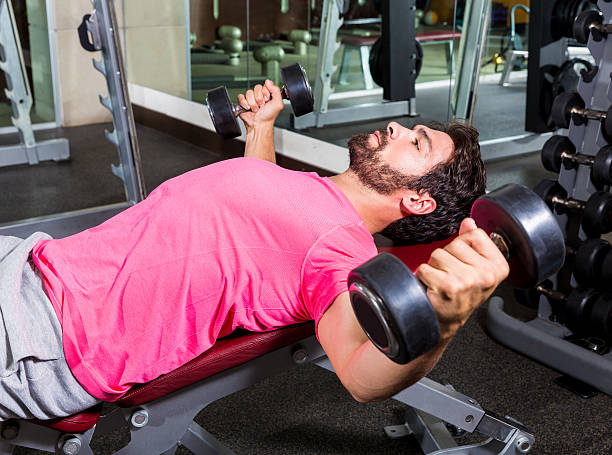
One of my personal favorite chest exercises, the incline dumbbell chest fly targets the upper chest muscles, providing a stretch and contraction that enhances muscle growth and definition in the upper chest region.
How to do it:
- Set an adjustable bench to a 30-45 degree incline.
- Lie back on the bench with a dumbbell in each hand, palms facing inward.
- Extend your arms upward directly above your chest, slightly bending your elbows.
- Lower the dumbbells out to the sides in a wide arc until you feel a stretch in your chest.
- Bring the dumbbells back together in a controlled manner, squeezing your chest muscles at the top.
- Repeat for the desired number of repetitions.
7. Decline Dumbbell Chest Press
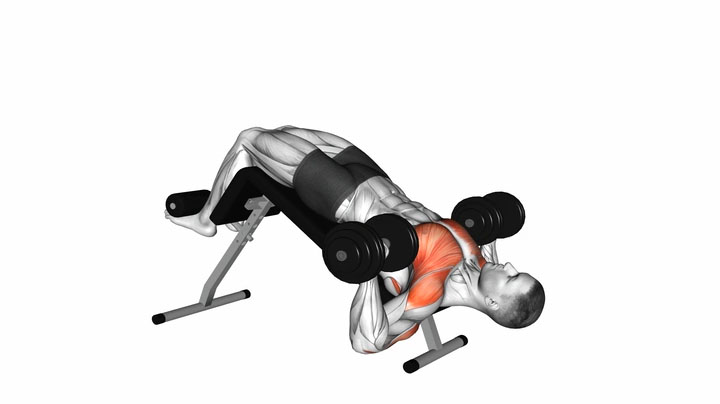
The Decline Dumbbell Chest Press is a great exercise that focuses on the lower part of the pectoral muscles, an area often neglected by conventional flat bench exercises. This is the best exercise for targeting the lower pecs, leading to balanced development of the chest (Muyor et al., 2021).
As you do this exercise, you will notice that it provides an enhanced stretch at the bottom of each rep, with an increased range of motion.
How to do it:
- To execute the Decline Dumbbell Chest Press, begin by setting your bench to a 15 to 30-degree decline.
- Start with both dumbbells held directly above your chest, arms fully extended but not locked out at elbows; this is to prevent unnecessary strain on joint areas while maintaining muscular engagement.
- Slowly lower both weights in a controlled manner towards your chest until they are parallel or slightly below shoulder level. This phase is crucial as it stimulates muscle fibers and initiates growth.
- Powerfully press back up to starting position while keeping tension on your chest throughout motion; avoid clashing weights together at top as this can limit time under tension and muscular involvement.
Incorporating Decline Dumbbell Chest Press into your routine offers not only aesthetic benefits in the form of lower chest definition but also functional advantages.
8. Standing Cross-body Dumbbell Raise

The Standing Cross-body Dumbbell Raise is an exercise that primarily hits the upper pectoral muscles while simultaneously engaging your deltoids and core.
The unique cross-body motion of this exercise forces the body to maintain stability, working on those smaller stabilizing muscles which are often neglected in more traditional workouts.
How to do it:
- To perform this exercise, begin by standing upright with a dumbbell in each hand at arm’s length, palms facing inward.
- With a slow and controlled motion, raise one dumbbell across the body diagonally towards the opposite shoulder as if drawing a sword from its sheath.
- As you do this, rotate the torso slightly towards the same side while keeping feet firmly planted on ground – it’s this twist that really engages your core and enhances balance.
- Keep going until the dumbbell is level with your shoulder – at this point, you should feel a strong contraction in your chest and shoulder.
- Hold for a moment at top of movement before slowly lowering back down along the same diagonal path to starting position before alternating sides.
This exercise is unique due to its focus on unilateral movements – working one side of the body separately from the other – which aids in balancing any strength discrepancies between two sides of the body..
9. Dumbbell Floor Press
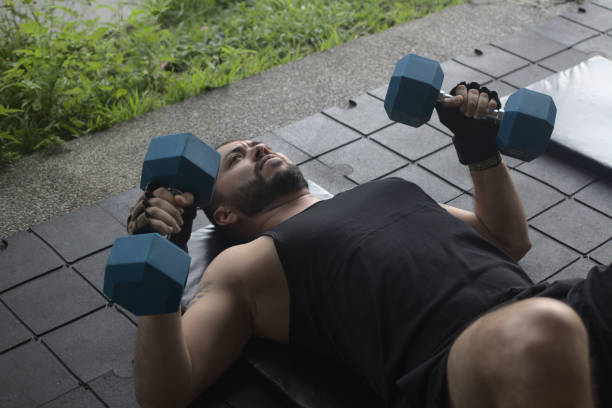
The dumbbell floor press is a variation of the traditional bench press that can help relieve shoulder strain while still effectively targeting the chest muscles. It’s performed lying on the floor rather than a bench.
How to do it:
- Lie on the floor with a dumbbell in each hand, elbows bent and upper arms resting on the floor.
- Press the dumbbells upward until your arms are fully extended.
- Lower the dumbbells back down in a controlled manner until your elbows touch the floor.
- Repeat for the desired number of repetitions.
10. Dumbbell Svend Press
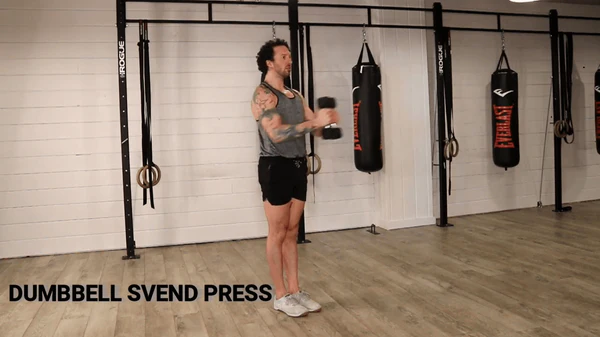
The Dumbbell Svend Press is an exercise that specifically targets the inner chest muscles. While it may appear unorthodox to some, its effectiveness lies in its unique approach to activating the sternal heads of the pectoralis major, which are very difficult to isolate.
How to do it:
- Hold a dumbbell with both hands, directly in front of your chest.
- Press it forward, squeezing the weight together as firmly as possible during execution, which engages and activates your inner pectoral muscles effectively.
- Bring it back towards your chest in a controlled motion, keeping your hands and elbows level.
One notable aspect of this exercise is its ability to recruit stabilizing muscles throughout your upper body. You will find that aside from targeting inner chest muscles, it also works out shoulder muscles, triceps, and even core muscles, making it an overall beneficial addition to any workout program.
11. Dumbbell Renegade Row

The Dumbbell Renegade Row is a compound exercise that targets multiple muscle groups including the chest, back, shoulders, and core. It’s an effective way to build strength and stability throughout the upper body while also improving coordination and balance (Baig & Bordoni, 2023).
How to do it:
- Start in a high plank position with a dumbbell in each hand, wrists aligned under shoulders.
- Keeping your core engaged and hips stable, row one dumbbell up towards your ribcage while stabilizing with the opposite arm.
- Lower the dumbbell back down to the ground in a controlled manner.
- Alternate rowing sides, maintaining proper form throughout.
- Repeat for the desired number of repetitions on each side.
Consistency and progression are the key aspects; gradually increase the weight or reps as your strength improves while maintaining proper form.
Experiment around with different exercises, order or rep ranges until you find what works best for you – because at the end of the day, a perfect routine isn’t one-size-fits-all but tailor-made for individual needs.
The Benefits of Using Dumbbells for Chest Workouts
Dumbbells are often overlooked in favor of barbells or weight machines, but they have a unique purpose in strength training and muscle building. Although all chest workouts have their own benefits, dumbbells offer some specific benefits that contribute to their success in the world of lifting weights.
Better Range of Motion
Incorporating dumbbell exercises into your chest workout routine allows for a better range of motion. Unlike larger equipment such as barbells or machines, dumbbells allow for a more natural movement pattern, enabling full stretch and contraction of the pectoral muscles.
This not only stimulates optimal growth but also improves flexibility and power. Using a full range of motion during chest workouts promotes muscle growth while enhancing flexibility and reducing the risk of injury.
Bench press at full range of motion with dumbbells leads to greater neuromuscular adaptations, as shown in a study comparing full ROM and partial ROM bench press (Martínez-Cava et al., 2022).
Additionally, the deeper range of motion with dumbbells allows for stronger contractions, ultimately increasing overall power output.
Strengthening Stabilizer Muscles for Balance
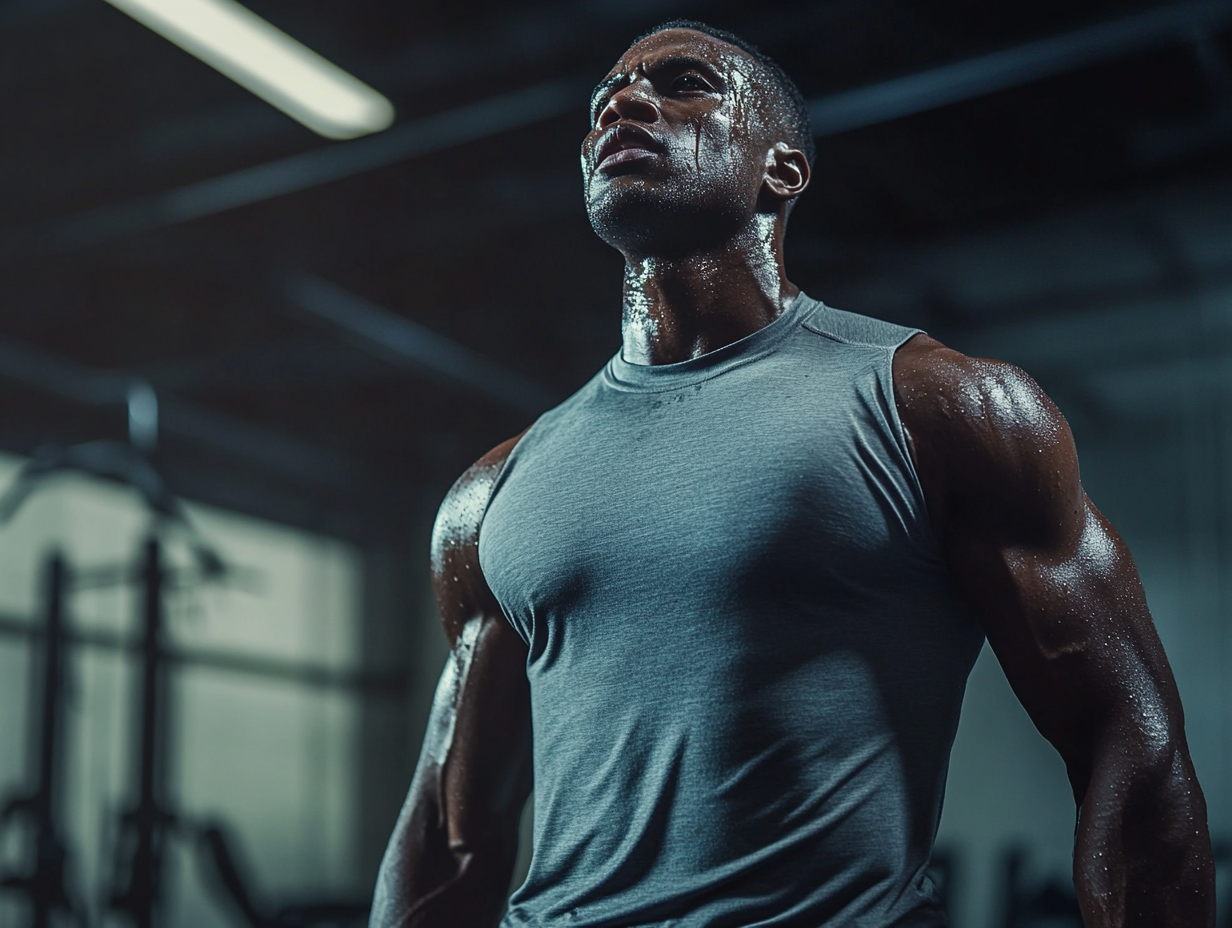
When trying to build a balanced physique, it’s important to consider not only the primary muscle groups but also the stabilizer muscles. Stability training is crucial, particularly in chest workouts with dumbbells, where balance largely influences safety and effectiveness.
Stabilizer muscles, crucial for steadying the body during exercises, protect joints from strain. Dumbbell chest workouts engage these stabilizers, strengthening often overlooked muscle groups.
Exercises like the dumbbell chest press or fly involve not just the pecs but also the rotator cuff and deltoids, promoting stability as arms move weights independently. This corrects muscular imbalances over time, supporting symmetrical development in strength and size across the chest.
Stability training also enhances overall body balance, coordination, and joint strength, improving performance in various sports and daily activities.
Reducing the Risk of Injuries
Dumbbells provide flexibility, allowing more control over movements and reducing strain on joints compared to barbell exercises, which can constrain natural movement patterns and stress joints like the shoulders and wrists.
This approach alleviates pressure on joints, significantly lowering the risk of injuries. Dumbbell chest exercises, such as presses or flyes, can benefit individuals recovering from injuries or with pre-existing joint conditions.
The adjustable range of motion helps cater to specific comfort levels and restrictions while still providing effective muscle stimulation. By controlling alignment and trajectory, you can customize your workouts to avoid discomfort or pain often encountered with other equipment.
With proper form and technique, dumbbell exercises can strengthen joint stability and strengthen stabilizer muscles.
Balanced Muscle Development
Dumbbell exercises excel in promoting balanced muscle development, fostering symmetrical growth.
The relationship between muscle size and bench press performance highlights that chest-focused exercises contribute significantly to larger muscle size (Akagi et al., 2013).
Unlike barbells, dumbbells require each side to lift independently, making sure there is equal workload and muscle development. This prevents asymmetry, leading to aesthetically pleasing and balanced pec muscles.
Additionally, focusing on balanced development reduces strength discrepancies between sides, which also reduces injury risk.
Warm-Up Essentials: Preparing Your Body for Optimal Performance
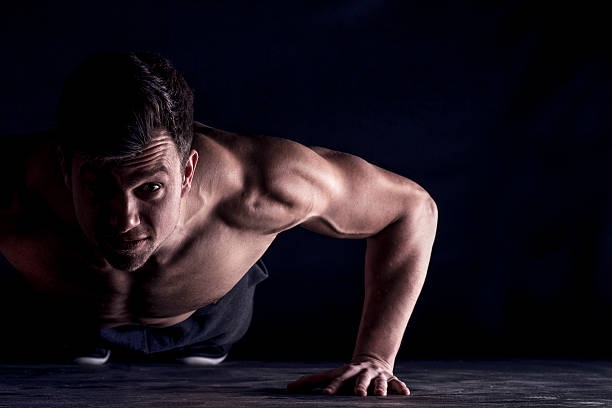
Before engaging in intense strength training, a proper warm-up is essential to prepare the body and reduce the risk of injuries.
The warm-up aims to enhance muscle elasticity, stimulate blood circulation, and gradually increase the heart rate.
Start with 5-10 minutes of light cardio, such as brisk walking or jogging, to raise body temperature and activate the cardiovascular system. Next, incorporate dynamic stretching, focusing on upper body movements like arm circles or twists to engage shoulder mobility.
Finally, perform exercise-specific movements with lighter weights, known as warm-up sets, to align motor patterns and prepare muscles for heavier weights.
Example Dumbbell Chest Workout Routine
Dumbbell Chest Workout 1: Strength and Power Focus
- Flat Bench Dumbbell Press – 4 sets of 6-8 reps
- Incline Dumbbell Fly – 3 sets of 10 reps
- Dumbbell Pullover – 3 sets of 12 reps
- Dumbbell Floor Press – 3 sets of 8 reps
- Standing Cross-body Dumbbell Raise – 3 sets of 12 reps per side
Dumbbell Chest Workout 2: Hypertrophy and Endurance Focus
- Decline Dumbbell Press – 4 sets of 10-12 reps
- Dumbbell Squeeze Press – 3 sets of 15 reps
- Incline Dumbbell Press – 4 sets of 8-10 reps
- Dumbbell Fly (Flat Bench) – 3 sets of 12 reps
- Dumbbell Renegade Row – 3 sets of 10 reps per side
Conclusion
In conclusion, dumbbells offer a versatile and effective tool for improving chest muscle development and overall upper body strength. Whether you’re looking to diversify your workout routine beyond traditional bench presses or seeking specific gains in muscle symmetry and strength, incorporating a variety of dumbbell exercises can significantly improve your results.
As you explore these 11 dumbbell chest exercises, remember the importance of progression and proper form to make sure your safely and effectively lifting. Each exercise not only targets the chest but also engages supporting muscle groups, which enhances stability and overall functional strength.
Embrace the journey of fitness with patience and persistence, and let the versatility of dumbbells lead you towards achieving your peak physical potential. Let’s get to lifting those dumbbells!
Sources
- Ferreira DV, Ferreira-Júnior JB, Soares SR, Cadore EL, Izquierdo M, Brown LE, Bottaro M. Chest Press Exercises With Different Stability Requirements Result in Similar Muscle Damage Recovery in Resistance-Trained Men. J Strength Cond Res. 2017 Jan;31(1):71-79. doi: 10.1519/JSC.0000000000001453. PMID: 27100318.
- Solstad TE, Andersen V, Shaw M, Hoel EM, Vonheim A, Saeterbakken AH. A Comparison of Muscle Activation between Barbell Bench Press and Dumbbell Flyes in Resistance-Trained Males. J Sports Sci Med. 2020 Nov 19;19(4):645-651. PMID: 33239937; PMCID: PMC7675616.
- Christian, J. R., Gothart, S. E., Graham, H. K., Barganier, K. D., & Whitehead, P. N. (2023). Analysis of the Activation of Upper-Extremity Muscles During Various Chest Press Modalities. Journal of Strength and Conditioning Research, 37(2), 265-269. DOI: 10.1519/JSC.0000000000004250
- Martínez-Cava, A., Hernández-Belmonte, A., Courel-Ibáñez, J., Morán-Navarro, R., González-Badillo, J. J., & Pallarés, J. G. (2022). Bench Press at Full Range of Motion Produces Greater Neuromuscular Adaptations Than Partial Executions After Prolonged Resistance Training. Journal of Strength and Conditioning Research, 36(1), 10-15. DOI: 10.1519/JSC.0000000000003391
- Muyor, J. M., Rodríguez-Ridao, D., & Oliva-Lozano, J. M. (2021). Comparison of Muscle Activity between the Horizontal Bench Press and the Seated Chest Press Exercises Using Several Grips. Journal of Strength and Conditioning Research, 35(7), 1943-1950. DOI: 10.1519/JSC.0000000000004059
- Akagi, R., Tohdoh, Y., Hirayama, K., & Kobayashi, Y. (2013). Relationship of Pectoralis Major Muscle Size with Bench Press and Bench Throw Performances. Journal of Strength and Conditioning Research, 27(12), 3361-3365. DOI: 10.1519/JSC.0000000000000306
- Baig, M. A., & Bordoni, B. (2023). Anatomy, Shoulder and Upper Limb, Pectoral Muscles. In StatPearls. StatPearls Publishing







